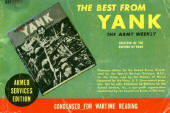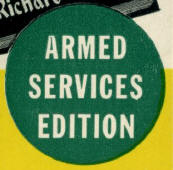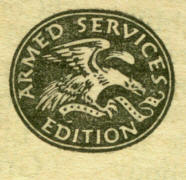 |
Armed Services Editions |
|
Click the group of books beginning with number:
|
I realize that most paperback collectors do not share my passion for acquiring these remarkable books, but this is my own favorite portion of the web site. When I pick up a few at a book fair, there is inevitably a distinguished, slightly older gentleman in line behind me waiting to check out that asks to hold one, then gets all misty-eyed and has a story to tell about them. The ASE’s were some of the most heartfelt mementoes carried by U.S. soldiers, sailors and marines during the war. ASE’s were commissioned in 1943 as a recommendation of the Council of Books in Wartime, which formed the year before. The Council picked the books and sold them to the Departments of the Army and Navy for cost (about 6¢) plus 10% overhead. A half-cent per copy royalty was paid to both the publisher and the author. Many authors tried to refuse the payment on grounds of patriotism, but the council refused to set that precedent. More than 70 publishers and 12 printers produced 123 million copies of 1,322 numbered issues, according to the Library of Congress; though at least two universities claim to have 1,324 in their collections. Collector Brian Anderson solves this riddle for us. ASE numbers 717 & 718 combine to make Webster's New Handy Dictionary, but they were reissued later with slight variations. Those revised volumes make the other two collectible books in the run. The ASE's were designed to fit in a fatigue uniform pocket, the smaller ones in the breast pocket, the larger ones in the jacket side pocket. Based on the size of either the standard pulp magazine (for the larger ASE’s) or the Reader’s Digest (for the smaller ones), the books were printed and bound in tandem pairs, one atop the other, then stapled on the side and cut apart. There were several unsuccessful attempts by conservative members of Congress to censor the books “our boys” were reading overseas. When he found out, E.B. White commented: “I always like having a book banned. It shows somebody has read it.” There were 654 lettered-ASE's. The A through J series maintained numerical sequence (so that A-30 was followed by B-31, etc). Starting with the K-series, the books were all renumbered, beginning with 1 (so there is a K-1, L-1, M-1, etc). The numbered books started with #655. Some of the real oddities in the ASE series were several true Paperback Originals (which the Library of Congress called "Made Books"). The ASE's all bore cover pictures of the hardcover books from which the volumes were reprinted. The PBO ASE's, usually compilations of selected short stories or poems, bore images of books that didn't really exist. Most were by classic authors such as Elizabeth Barrett Browning, Edgar Allan Poe and Henry Wadsworth Longfellow. One in particular, Ernie Pyle's Brave Men, was reprinted after the ASE (and is still in print today). I have compiled a list of the "Made Books." I gathered these entries from the various pages of John Y. Cole's book Books in Action, then sorted them for the modern collector; first by author, and then by book number. (Dr. Cole wrote numerous books while head of The Center for the Book for 30 years at the Library of Congress.) Books in Action, which is my own primary reference source for these books, is now online. Click HERE. The first colophon at the left was on every cover. The bottom one was added to the last page of a book only if that page happened to be blank. This actually happened rather rarely. It was obvious that every scrap of paper counted during this period in history, and most books were arranged so that the text went all the way to the last page. Many thanks to Brian Anderson, who spent many long hours comparing his collection to the BookScans database and sending me scans of his books. As a results of his efforts, and those of other contributors: The Armed Services Edition visual index is now complete.
Updated November, 2020
|

